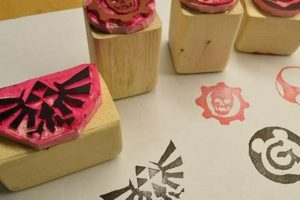The construction of self-made undergarments that provide shaping and support is a historical and contemporary practice. This form of garment creation allows individuals to tailor the fit and style of such garments to their specific body measurements and aesthetic preferences. For example, an individual might choose to create a close-fitting underbust garment from heavy coutil fabric, incorporating spiral steel boning for structure.
Constructing supportive garments from home offers benefits such as cost savings compared to purchasing ready-made items, the ability to customize designs, and the satisfaction of mastering a traditional craft. Historically, this practice empowered individuals to control their appearance and adapt to changing fashion trends. The skill also allowed for the repair and modification of existing garments, extending their lifespan and reducing textile waste.
The following sections will detail the materials, tools, and techniques required for the successful fabrication of such garments, as well as provide guidance on pattern drafting and fitting adjustments. These instructions aim to equip the reader with the knowledge necessary to undertake the creation of personalized and well-fitting supportive undergarments.
Construction Tips for Shaped Undergarments
The following are considerations for the successful creation of structured undergarments. Adhering to these guidelines can improve the fit, durability, and overall quality of the finished product.
Tip 1: Fabric Selection: Choose a tightly woven, non-stretch fabric such as coutil, which provides the necessary strength and stability for shaping. Avoid lightweight or stretchy fabrics that will not hold their shape under tension.
Tip 2: Bone Selection: Opt for steel boning, either spiral or flat, for structural integrity. Spiral steel boning is suitable for curved areas, while flat steel boning provides support along straight lines. Plastic boning is generally insufficient for significant shaping.
Tip 3: Pattern Accuracy: Ensure the pattern is drafted or adjusted to precise measurements. Inaccurate pattern pieces will result in a poorly fitting and potentially uncomfortable garment. Create a mock-up from inexpensive fabric to test the fit before cutting into the final fabric.
Tip 4: Seam Allowance Consistency: Maintain a consistent seam allowance throughout the construction process. This ensures that all pieces align correctly and that the finished garment conforms to the intended dimensions.
Tip 5: Bone Channel Construction: Construct bone channels that are slightly wider than the boning to allow for ease of movement and prevent the boning from wearing through the fabric. Stitch bone channels securely to prevent shifting or displacement of the boning.
Tip 6: Lacing Reinforcement: Reinforce the lacing area with sturdy fabric and metal grommets to prevent tearing or distortion. Distribute the lacing pressure evenly across the reinforcement panel.
Tip 7: Proper Fitting: Schedule multiple fitting sessions during the construction process to ensure a comfortable and supportive fit. Make adjustments to the pattern as needed to accommodate individual body contours.
These tips serve to enhance the outcome of shaped garment construction, ensuring a durable, comfortable, and aesthetically pleasing finished piece. Attention to detail during each stage of the process is crucial for achieving optimal results.
The following sections will discuss additional considerations for achieving professional-level results in the creation of structured undergarments.
1. Pattern Drafting
Pattern drafting serves as the foundational element in the creation of shaped undergarments. The accuracy and precision of the pattern directly influence the fit, comfort, and aesthetic outcome of the finished product. Without a properly drafted pattern, achieving the desired silhouette and support is exceedingly difficult.
- Measurement Acquisition
Accurate body measurements are paramount to successful pattern drafting. Girth measurements at the bust, waist, and hips, as well as vertical measurements from shoulder to waist and waist to hip, are essential. Inaccurate measurements will result in a garment that is either too tight, too loose, or disproportionate. For example, a waist measurement that is several inches off can render the entire garment unwearable.
- Pattern Creation Methods
Several methods exist for pattern creation, including flat pattern drafting, draping, and using pre-existing patterns. Flat pattern drafting involves constructing a pattern from scratch using specific formulas and geometric principles. Draping involves manipulating fabric directly on a dress form to create the desired shape. Pre-existing patterns can be adapted and modified to individual measurements. Each method has its advantages and disadvantages, depending on the skill level of the maker and the complexity of the design.
- Pattern Truing and Adjustment
Once the initial pattern is drafted, it requires truing and adjustment to ensure smooth lines and accurate seam matching. Truing involves blending curves and straightening lines to create a visually pleasing and structurally sound pattern. Adjustments are made based on individual body variations and design preferences. A small bust adjustment, for instance, might be necessary to accommodate a fuller bust without altering the overall fit of the garment.
- Muslin Mock-Up and Fitting
Before cutting into the final fabric, it is standard practice to create a mock-up from inexpensive muslin. This allows for testing the fit and making further adjustments to the pattern. The muslin mock-up is fitted to the body, and any necessary alterations are marked directly on the fabric. This process minimizes the risk of errors in the final garment and ensures a comfortable and supportive fit.
The interplay between accurate measurements, appropriate pattern creation methods, precise truing and adjustment, and thorough fitting with a muslin mock-up is essential. Proper pattern drafting is the cornerstone of a well-constructed and functional shaped undergarment, allowing for personalization and a superior fit compared to mass-produced alternatives.
2. Fabric Selection
In the context of self-constructed structured undergarments, fabric selection is not merely an aesthetic choice; it is a determining factor in the garment’s structural integrity, shaping capabilities, and overall longevity. The chosen material directly impacts the garment’s ability to withstand tension, maintain its form, and provide the desired level of support. For example, using lightweight cotton will result in a garment that lacks the necessary rigidity to create a defined silhouette, whereas a heavy, tightly woven coutil is designed to resist stretching and distortio
n under pressure. The type of fabric selected dictates the success, or failure, of achieving the intended design.
The interrelationship between fabric characteristics and construction techniques is vital. A robust fabric, such as canvas or denim, may necessitate specialized needles and thread to ensure secure seams. Conversely, finer fabrics, such as brocade or silk, may require interfacing to provide additional support and prevent fraying. Furthermore, the fabric’s grain direction must be carefully considered during pattern placement to maximize its strength and minimize unwanted stretching or buckling. The proper selection of lining fabrics is also important. A breathable, skin-friendly material like cotton or linen can enhance comfort and prevent irritation.
In summary, fabric selection is a critical decision-making point in the construction of self-made shaped undergarments. The choice impacts not only the appearance but also the functionality and durability of the finished piece. A comprehensive understanding of fabric properties and their suitability for structural applications is essential for achieving professional-quality results. Neglecting this aspect can lead to a poorly constructed garment that fails to provide adequate support or maintain its shape over time.
3. Boning Channels
Boning channels are integral structural components in the construction of supportive undergarments. Their design, materials, and implementation directly influence the garment’s shape, support, and longevity. A thorough understanding of these channels is essential for successful fabrication.
- Functionality and Support
Boning channels serve to encase and constrain the boning elements within a garment. This constraint directs the boning’s supportive force, shaping the garment and the wearer’s body. Inadequate channel construction can lead to boning displacement, resulting in discomfort and diminished shaping.
- Material Selection
The material used for boning channels must be durable and resistant to abrasion. Common choices include coutil, twill tape, or sturdy cotton. The selected material should be compatible with the primary fabric of the garment to prevent differential shrinkage or distortion. Lightweight fabrics are generally unsuitable due to their propensity to tear or fray under stress.
- Construction Techniques
Accurate stitching is paramount in boning channel construction. Channels must be securely attached to the garment, with consistent seam allowances to ensure proper alignment and prevent boning from escaping. Multiple rows of stitching can enhance the channel’s durability and resistance to wear.
- Placement and Spacing
The strategic placement and spacing of boning channels determine the garment’s overall shape and support. Channels should be positioned to follow the natural curves of the body, providing targeted shaping and preventing unwanted bulging or distortion. Inadequate spacing between channels can result in a lack of support, while excessive spacing can compromise the garment’s shape.
Effective boning channel construction is a critical factor in the successful creation of shaped undergarments. By considering the functionality, material selection, construction techniques, placement, and spacing of these channels, the garment maker can achieve a durable, supportive, and aesthetically pleasing result. Neglecting any of these aspects will significantly compromise the quality and performance of the finished piece.
4. Fitting Adjustments
In the realm of self-made structured undergarments, achieving a precise and comfortable fit necessitates meticulous attention to fitting adjustments. These adjustments bridge the gap between a theoretical pattern and the unique contours of the human body, ensuring that the finished garment provides optimal support, shaping, and wearability. Without systematic fitting adjustments, a self-constructed undergarment may fail to meet the intended purpose or result in discomfort.
- Muslin Mock-up Analysis
The creation of a muslin mock-up serves as a critical first step in the fitting adjustment process. This inexpensive version of the garment allows for the identification of fit issues before cutting into the final fabric. Common problems revealed during this stage include gaping at the bust, wrinkling at the waist, or tightness across the hips. Addressing these issues on the muslin significantly reduces the risk of costly errors and ensures a more accurate final fit. For example, diagonal drag lines on the muslin often indicate a need to adjust the pattern for a fuller or more projected bust.
- Pattern Alteration Techniques
Based on the observations made during the muslin fitting, pattern alterations are implemented to refine the garment’s shape. Techniques such as pivoting, slashing, and spreading, or adding darts may be employed to address specific fit issues. For instance, a swayback adjustment, involving a horizontal slash across the back pattern piece and the removal of excess length, can eliminate unwanted pooling of fabric at the lower back. Accurate pattern alterations are essential for achieving a smooth and flattering silhouette.
- Boning Placement Refinement
Fitting adjustments also extend to the placement and orientation of boning channels. During the fitting process, it may become apparent that certain areas require additional support or that the existing boning configuration is causing discomfort. Subtle shifts in boning placement can significantly improve the garment’s shaping capabilities and enhance wearer comfort. For example, relocating a bone slightly to the side can alleviate pressure on a prominent hip bone.
- Lacing Gap Optimization
The lacing gap at the back of the undergarment provides critical adjustability and allows for incremental changes in fit. Adjustments to the lacing gap may be necessary to achieve the desired level of compression and shaping. A gap that is too wide may indicate that the garment is too large overall, while a gap that is too narrow suggests that the garment is too small. Precise adjustments to the side seams or back panels can optimize the lacing gap and ensure a secure and comfortable fit.
These fitting adjustments are not isolated steps but rather a series of interrelated refinements. Each alteration impacts the overall fit and balance of the garment, requiring careful consideration and iterative adjustments. This attention to detail distinguishes a professionally fitted self-constructed undergarment from a mass-produced alternative, yielding a garment that is both supportive and uniquely tailored to the individual’s body. The commitment to precise fitting adjustments ultimately translates to a more comfortable, flattering, and confidence-boosting result.
5. Lacing Strength
The structural integrity of a self-made shaping undergarment is fundamentally dependent upon the strength of its lacing system. This component bears the primary responsibility for achieving the desired silhouette and providing the necessary compression. Inadequate lac
ing strength directly translates to a failure of the garment to perform its intended function. For example, if the lacing panel fabric is insufficiently robust, the grommets may tear out under tension, rendering the garment unusable. Similarly, a weak lacing cord will stretch or break, negating the wearer’s ability to adjust the garment to the desired fit. The connection between lacing strength and the overall efficacy of a self-constructed undergarment is a direct cause-and-effect relationship.
Achieving sufficient lacing strength requires careful consideration of multiple factors. Fabric selection for the lacing panel must prioritize durability and resistance to tearing. Reinforcement with sturdy interfacing or additional fabric layers is often necessary, particularly around grommet placement. The grommets themselves should be constructed from a high-quality metal and installed using the appropriate tools to ensure a secure and lasting hold. Lacing cord selection is equally crucial. Synthetic cords, such as those made from nylon or polyester, generally offer greater strength and resistance to stretching compared to natural fibers like cotton. Furthermore, the lacing pattern and knotting technique contribute to the distribution of tension and the overall security of the system. A poorly executed lacing pattern can concentrate stress on specific grommets, increasing the likelihood of failure. The strategic importance of these elements cannot be overstated.
In conclusion, lacing strength is not merely a superficial detail but a core element determining the success or failure of a self-made shaping undergarment. A comprehensive understanding of the materials, construction techniques, and load-bearing principles involved is essential for creating a durable, functional, and aesthetically pleasing garment. Overlooking this critical aspect will inevitably lead to a compromised outcome, regardless of the skill invested in other areas of construction. The reliability of the lacing system ensures that the shaping properties of the garment remains effective over time.
Frequently Asked Questions
This section addresses common inquiries and misconceptions surrounding the construction of structured undergarments, offering concise and informative answers.
Question 1: What is the minimum skill level required to construct a shaped undergarment?
While advanced sewing skills are not strictly mandatory, a solid understanding of basic sewing techniques, including seam construction, fabric handling, and pattern interpretation, is highly recommended. Familiarity with specialized tools, such as grommet setters and boning cutters, is also beneficial.
Question 2: What are the most common fitting issues encountered during shaped undergarment construction?
Frequent fitting challenges include gaping at the bust, wrinkling at the waist, and tightness across the hips. These issues often stem from inaccurate measurements or a failure to adequately adjust the pattern to individual body contours. Creation of a muslin mock-up is essential for identifying and addressing these problems.
Question 3: What is the lifespan of a self-constructed shaped undergarment?
The lifespan of a self-constructed undergarment is dependent upon factors such as the quality of materials used, the precision of construction, and the frequency of wear. With proper care and maintenance, a well-made garment can last for several years. However, components such as boning and lacing may require periodic replacement.
Question 4: Is it possible to create a shaped undergarment suitable for daily wear?
Yes, shaping undergarments can be designed for daily wear, provided that comfort and mobility are prioritized. Selecting flexible boning materials, employing breathable fabrics, and ensuring a proper fit are crucial for creating a garment that can be worn comfortably for extended periods.
Question 5: What are the ethical considerations associated with shaped undergarment construction?
Ethical considerations include sourcing materials from sustainable and responsible suppliers, minimizing textile waste through efficient pattern layout and fabric usage, and ensuring fair labor practices if outsourcing any part of the construction process.
Question 6: How does the cost of a self-constructed shaped undergarment compare to a commercially produced one?
The cost comparison is variable. While materials for a self-constructed garment may initially seem less expensive, the time investment, specialized tools, and potential for errors can increase the overall cost. However, this approach offers the benefit of complete customization and potentially higher quality craftsmanship.
These responses offer a foundation for understanding aspects of structured garment construction. Additional research and experimentation are encouraged for achieving mastery in this area.
The next section will delve into resources available for expanding knowledge and skill in shaped garment creation.
Conclusion
The preceding discussion has explored the multifaceted nature of the craft of creating shaped undergarments. From pattern drafting and fabric selection to boning channel construction, fitting adjustments, and lacing strength, each element contributes critically to the final outcome. Mastery of these techniques is essential for producing a garment that meets functional and aesthetic requirements.
The information presented serves as a foundation for further exploration and practical application. Continued dedication to refinement and skill development will ultimately lead to enhanced proficiency in this intricate and rewarding endeavor. This knowledge empowers the individual to transcend the limitations of mass-produced garments, creating bespoke pieces that reflect both technical expertise and personal expression.







